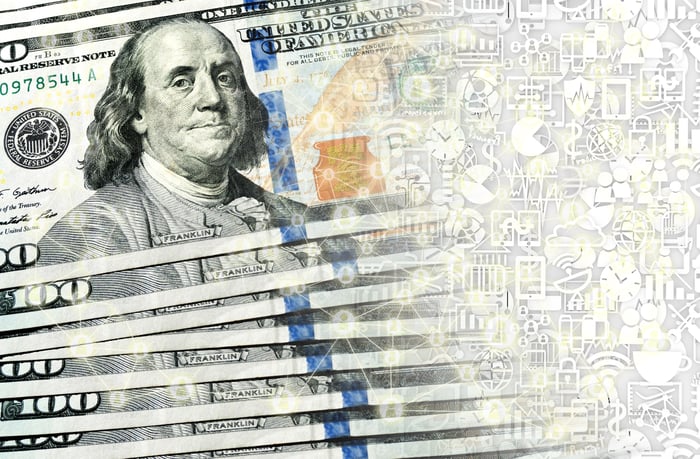Although the performance of the stock market has long been the preferred measure of investor success, the cryptocurrency market has run circles around Wall Street for some time. This year alone, the aggregate value of all digital currencies has more than tripled to $2.39 trillion, as of Dec. 23.
While there are a lot of factors influencing the cryptocurrency space, including the prospect of payment coin adoption in the real world, the most-exciting aspect is arguably the potential for creating decentralized applications (dApp) on blockchain.
The ability to transparently and immutability record financial and nonfinancial transactions provides almost limitless potential to developers. They can create financially focused applications for payments or lending, or perhaps build play-to-earn games on blockchain that promote 3D virtual environments (i.e., the metaverse). These applications can be applicable to both the consumer and enterprise landscapes.

Image source: Getty Images.
Crypto investors are enamored with Solana
It's the mammoth potential for smart contract-based dApp development that has folks so excited about Solana (SOL -10.93%), the fifth-largest cryptocurrency by market value ($58 billion). Smart contracts being the protocols that verify, facilitate, and enforce the negotiation of a contract between two parties.
Solana's claim to fame is its unbridled speed. To put things into context, Bitcoin (BTC -4.71%) and Ethereum (ETH -6.29%), the two most-popular blockchain-based networks, are capable of processing a respective 7 transactions per second (TPS) and 13 TPS. Meanwhile, Solana claims to be able to process (drum roll) 50,000 TPS. That's more than twice as fast as payment kingpin Visa, which processes at 24,000 TPS. Speed and scalability are critical to the future success of dApps.
Another aspect of Solana that's made it a very intriguing network is its unique proof-of-history protocol. Normally, validators have to talk to each other to determine how much time has elapsed between an event. With Solana, the proof-of-history protocol effectively makes that call, expediting the completion of transactions on the network.
The Solana development teams' investments in unbridled speed are starting to pay off. Solana has generated close to $3.2 million in protocol dApp revenue over the trailing 30 days, and it's brought in more than $12.1 million in dApp revenue this year, according to data from TokenTerminal.com.

Image source: Getty Images.
This crypto trio is running circles around Solana
Yet, Token Terminal also shows that three highly popular cryptocurrencies have left Solana in the dust, in terms of protocol dApp revenue, over the trailing 30 days and trailing year.
Ethereum
Maybe the least surprising cryptocurrency of all that's running circles around Solana in dApp revenue is Ethereum. Token Terminal lists Ethereum with just over $1 billion in revenue over the trailing 30 days and almost $4.8 billion over the trailing year. For some context, the $1 billion recorded over the past 30 days is 10 times higher than the No. 2 blockchain project.
The reason investors and dApp developers love Ethereum so much is because it was the first project to introduce smart contracts. These contracts are what allowed companies to consider moving beyond financially focused applications and consider Ethereum for tasks like supply chain management. There's a whole world of application beyond just sending and receiving money on blockchain, and Ethereum was the first to expose this.
Another factor working in Ethereum's favor is the mountain of support it's receiving. The Enterprise Ethereum Alliance is a body of more than 100 companies, some of which are well-known, whose purpose is to promote the use of the Ethereum blockchain. Although network congestion isn't exactly a good thing, the sheer fact that Ethereum does deal with congestion and higher transaction fees demonstrates its popularity.

Image source: Getty Images.
Axie Infinity
Another cryptocurrency that's handily outpaced Solana in the dApp revenue department is play-to-earn blockchain-based game Axie Infinity (AXS). Axie has brought in $105 million over the past 30 days -- it's the aforementioned No. 2 behind Ethereum -- and $1.26 billion over the trailing year.
The game, which is built on the Ethereum blockchain, is fairly straightforward. Users collect, raise, breed, and battle these monster-like creatures known as Axies. A minimum of three Axies are needed to go to battle, with the winner picking up experience points that are used to improve certain aspects of their Axies.
What makes this blockchain project so intriguing is that each Axie is a non-fungible token (NFT). In other words, users retain ownership of their virtual creations which can be used within gameplay or sold in a marketplace. That's completely different from legacy game development where companies maintain ownership of all creations.
With stock and crypto investors absolutely enamored with the prospects of the metaverse, Axie Infinity and its huge dApp revenue haul over the past year are proof of its potential.

Image source: Getty Images.
Avalanche
A third popular cryptocurrency that's generated substantially more protocol dApp revenue than Solana is Avalanche (AVAX -12.17%). Over the past 30 days, Avalanche has brought in approximately $14.7 million, with the project netting $37.7 million in dApp revenue over the trailing year.
The lure of Avalanche's smart contract-based network is both its incredible speed and the compatibility of its blockchain to other networks. In terms of the former, the project's website notes it can process at more than 4,500 TPS, with a block finality of less than two seconds (i.e., transactions validate and settle in less than two seconds). By comparison, Bitcoin and Ethereum process transactions in a respective average of 60 minutes and six minutes.
As I've previously pointed out, what could really pull dApp developers to Avalanche in the months and years to come is the compatibility of its blockchain. With the Ethereum Virtual Machine -- the software platform that lets developers create dApps on the Ethereum blockchain -- already operating on Avalanche's network, it wouldn't be at all surprising if developers switched their projects to Avalanche to take advantage of lower costs and faster execution.





